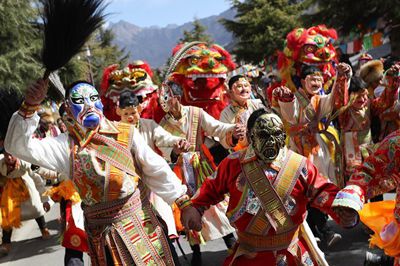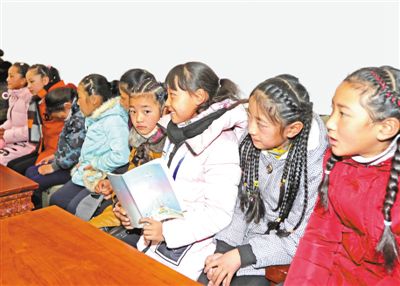|
In recent years, the completion and operation of the Qinghai-Tibet railway has greatly spurred growing demand for tourism, cars, housing, catering and entertainment. In 2008 Tibet's retail sales of consumer goods came to 12.908 billion yuan, up 15.2 percent over 2007. Of these, the retail sales of consumer goods in urban areas stood at 6.428 billion yuan, up 14 percent over 2007; the retail sales of consumer goods at the county level or below totaled 6.48 billion yuan, up 16.4 percent over 2007. Looking at particular sectors, the wholesale and retail trade in 2008 yielded 10.459 billion yuan, up 18.1 percent over 2007; the retail sales for the lodging and catering sector recorded 1.951 billion yuan, up 3.8 percent over 2007; and the retail sales of other sectors hit 498 million yuan, up 7.3 percent over 2007. In the wholesale and retail sector above a designated size, retail sales of clothing, shoes, hats and textiles grew by 35.4 percent, that of petroleum products by 30.9 percent, that of gold, silver and jewelry by 20.4 percent, and that of food, beverages, tobacco and alcohol by 68 percent. Posts and telecommunications have seen unprecedented growth. In 1959, Tibet had only 276 telephones, mostly located in large and medium-sized cities like Lhasa. The earnings of postal and telecommunications services then totaled only 990,000 yuan. Now, Tibet has formed an advanced communications network covering every part of the region with Lhasa as the center, providing services such as optical cable and satellite transmission, combining program controlled exchange, satellite communication, digital communication and mobile communication. Statistics show that over the past 20 years the business transactions of the postal and telecommunications services in Tibet have grown at an annual rate of 34.4 percent, reaching 4.173 billion yuan in 2008, up 35.1 percent over 2007. By the end of 2008, telephone (including mobile phone) subscribers in Tibet totaled 1.562 million, an increase of 117,000 subscribers over the previous year. Now in Tibet there are 55 telephones per 100 persons, with the rural telephone subscribers numbering almost 27,000 households. In addition, Tibet has over 800 Internet websites, providing services to about 200,000 netizens. In 2008, the balance of deposits in both renminbi and foreign currencies in Tibet's financial institutions stood at 82.902 billion yuan, up 28.9 percent over 2007, with the savings of both urban and rural residents hitting 18.536 billion yuan, up 15.8 percent over the previous year. Also in 2008, the balance of loans in both renminbi and foreign currencies from financial institutions amounted to 21.932 billion yuan, up 13.3 percent over2007; cash receipts for the financial institutions totaled 79.532 billion yuan, up 3.8 percent over 2007; cash disbursements were 82.985 billion yuan, up 4.2 percent over the previous year; and the net cash injections amounted to 3.453 billion yuan, an increase of 407 million yuan over 2007. Tourism is playing an increasingly important role in Tibet's tertiary industry. Though it has unique natural, cultural and tourism resources, Tibet developed its tourism sector very late. Before 1978, there was almost no tourism in Tibet. In 1980, there was only one hotel that could receive overseas tourists, with fewer than 100 beds. The reform and opening-up policy has helped Tibet open its long-closed doors to the outside world, enabling its tourism to gain a considerable expansion. It has greatly improved its tourist reception capabilities, with 93 tour agencies of various kinds, and 62 star-rated hotels. The total fixed assets of the region's tourism sector stand at 1.78 billion yuan, with 12,032 employees. Since the completion and operation of the Qinghai-Tibet railway, Tibet's tourism has entered a period of rapid development. In 2008, 2,246,400 Chinese and foreign tourists visited Tibet, a figure bigger than the total number of tourists who went to Tibet between 1980 and 1997. Tourism revenue in 2008 reached 2.259 billion yuan, almost equaling the total revenue generated between 1980 and 2000. Tibet has now formed a tourism resources pattern, with Lhasa as the center, supplemented by Shigatse, Shannan and Nyingchi, and extending to Nagqu, Ngari and Qamdo (see Fig. 7). |
- Home
- News |Tibet |Exclusive |China |World |Other Tibetan-Inhabited Area |Tibet through the Eyes of Foreigners |Related News
- Documents |White Papers |Others
- Photo |Politics |Economy & Society |Culture & Religion |Human & Nature |Beautiful Tibet |Other Tibetan-Inhabited Area |Exchanges |Related
- Video |News |Documentary |Micro-Video |Entertainment
- Art
- Tourism
- In Focus
- About Tibet






